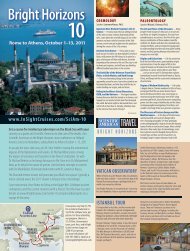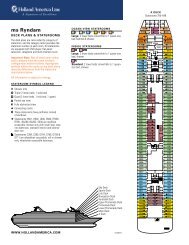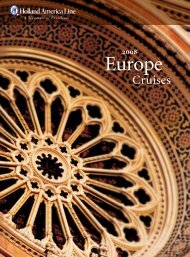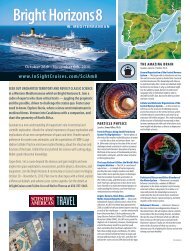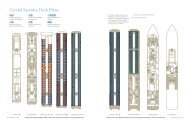Croatian cultural heritage - Business - Hrvatska turistiÄka zajednica
Croatian cultural heritage - Business - Hrvatska turistiÄka zajednica
Croatian cultural heritage - Business - Hrvatska turistiÄka zajednica
You also want an ePaper? Increase the reach of your titles
YUMPU automatically turns print PDFs into web optimized ePapers that Google loves.
17 18<br />
19 20<br />
21<br />
22<br />
is an important part of <strong>Croatian</strong> history. It was the centre of<br />
the early medieval <strong>Croatian</strong> kingdom, where <strong>Croatian</strong> princes<br />
and kings ruled from the 9th century until the unification<br />
with Hungary in the 12th century.<br />
Thus, unlike most Dalmatian cities which were erected on<br />
the foundations of ancient cities, Šibenik was the first original<br />
major <strong>Croatian</strong> coastal city. It was founded in the 11th<br />
century at the time of King Petar Krešimir IV and many still<br />
call it Krešimir’s city. At the time of King Zvonimir the capital<br />
city of Croatia was Knin, which we call Zvonimir’s city even<br />
today.<br />
The best known and most valuable <strong>cultural</strong> monument of the<br />
Šibenik part of Croatia is the Šibenik Cathedral, protected as<br />
a World Heritage Site by UNESCO. There is also the picturesque<br />
town of Primošten with its vineyards, and a number of<br />
ancient archaeological sites, particularly on Bribirska Glavica<br />
in the vicinity of Knin. Among religious buildings, the Franciscan<br />
monastery on the island of Visovac (1) is of exceptional<br />
beauty. It has a unique position on a small island in the<br />
middle of the lake near the expansion of the river Krka. Not<br />
far away is the Orthodox Monastery of St. Archangel in the<br />
canyon of the river Krka (3), which is, with the already mentioned<br />
Krupa Monastery, considered to be the most valuable<br />
monument of the Serbian Orthodox Church in Croatia.<br />
A sort of trademark of this part of Dalmatia are a number<br />
of fortresses, a testimony to the tumultuous past. In Šibenik<br />
there are three monumental forts that stand out, Saint John,<br />
Saint Anne and Šubićevac (2), and the only entry into Šibenik<br />
from the sea, is through the narrow passage of Saint Anthony<br />
(8), where the monumental 16th century fortress of St. Nicholas<br />
is located (9). An interesting newly constructed church in<br />
the village of Kijev, located at the foot of the <strong>Croatian</strong> Dinara<br />
Mountains (6), is a testimony to the suffering endured in recent<br />
wars.<br />
The Šibenik area is known for its many picturesque places,<br />
such as Skradin, along the river Krka (5) or Prvić Šepurine<br />
on the island of Prvić (4). There are also picturesque villages<br />
in Dalmatian Zagora, from which the most famous <strong>Croatian</strong><br />
sculptor Ivan Meštrović originates. For his last place of rest<br />
he chose his native village Otavice, where he built a unique<br />
mausoleum (7).<br />
The most important <strong>cultural</strong> monument of the Šibenik part<br />
89






